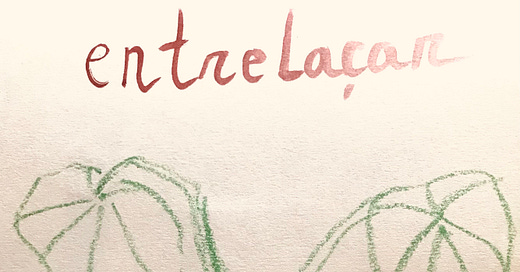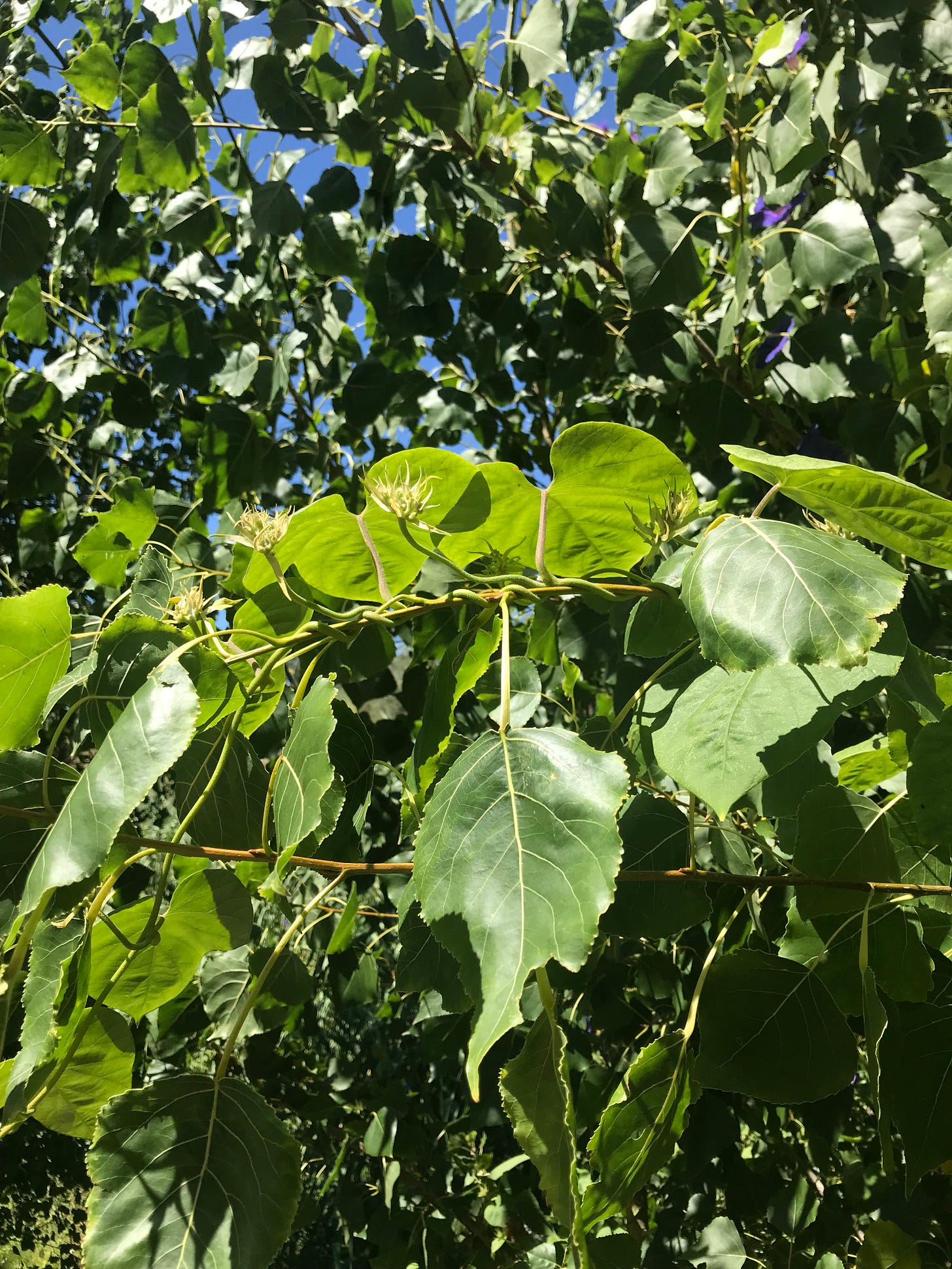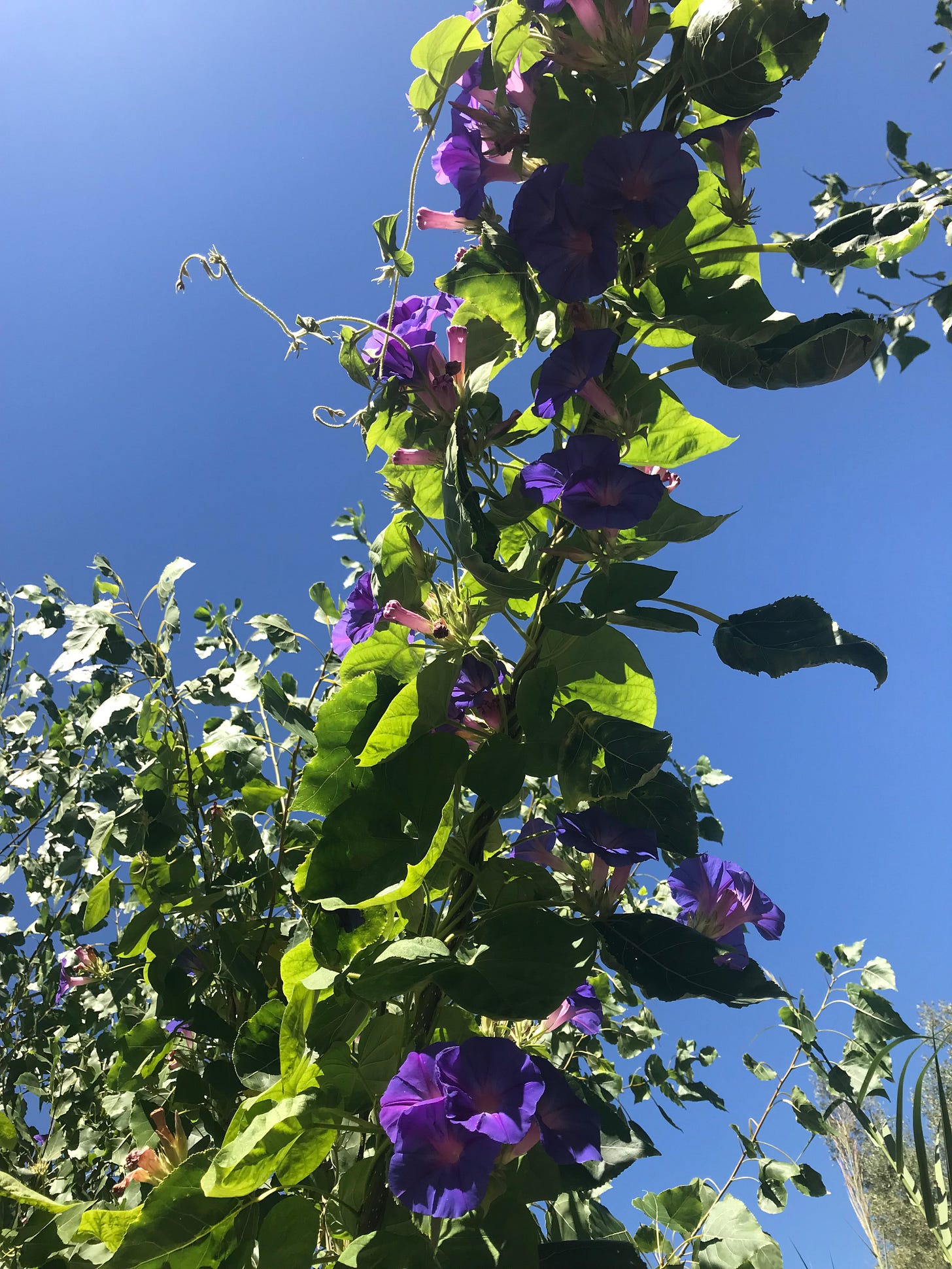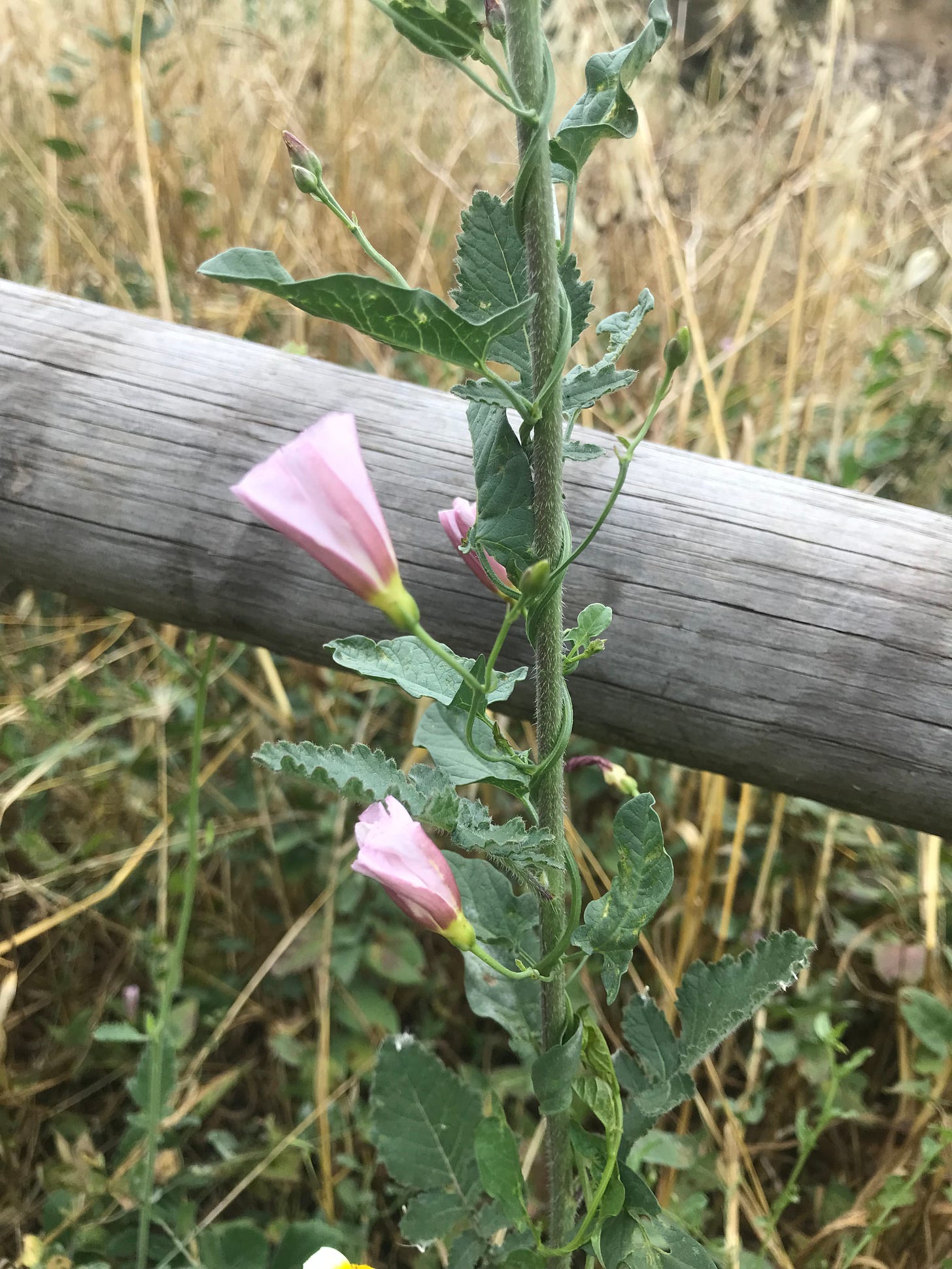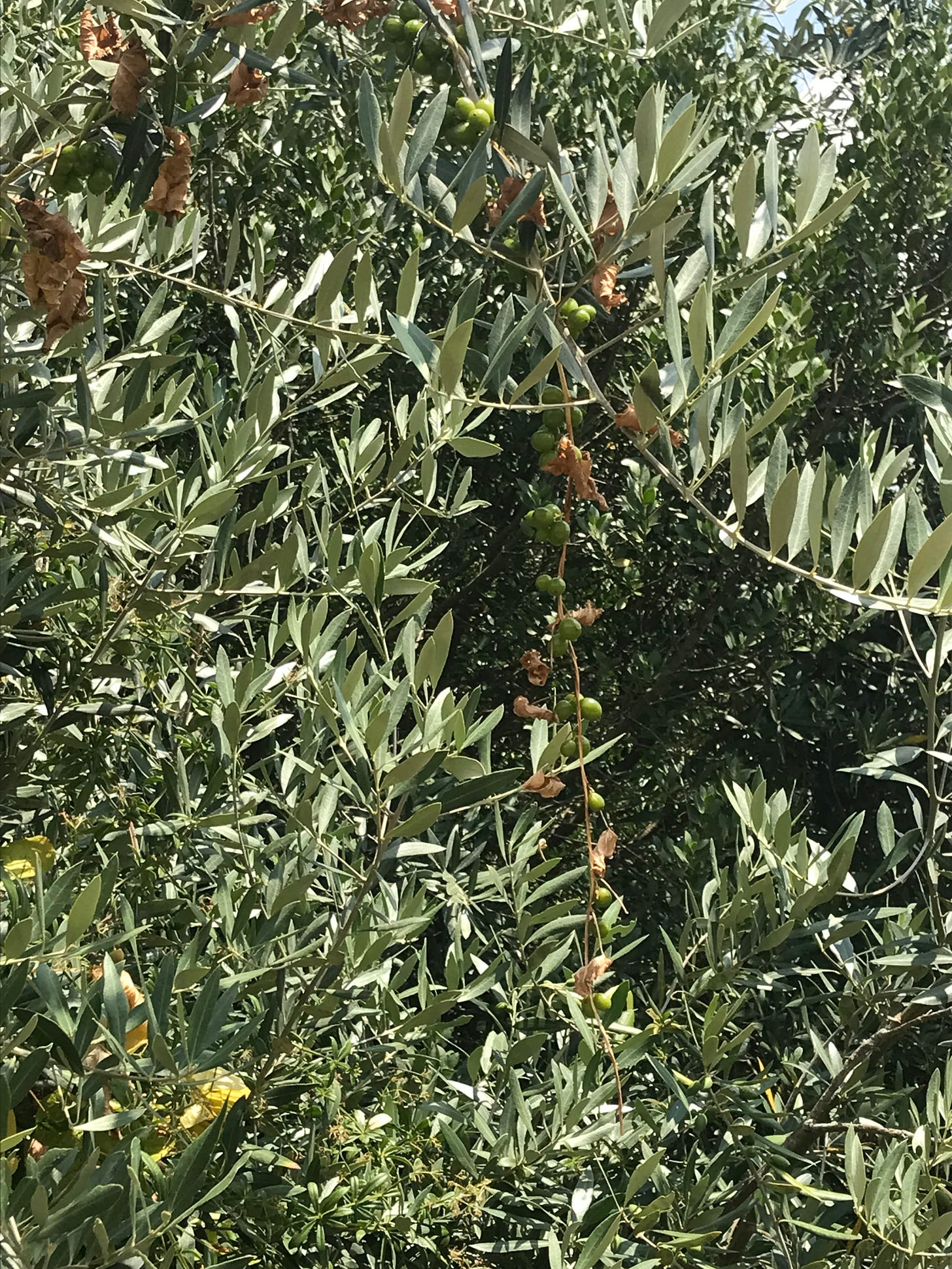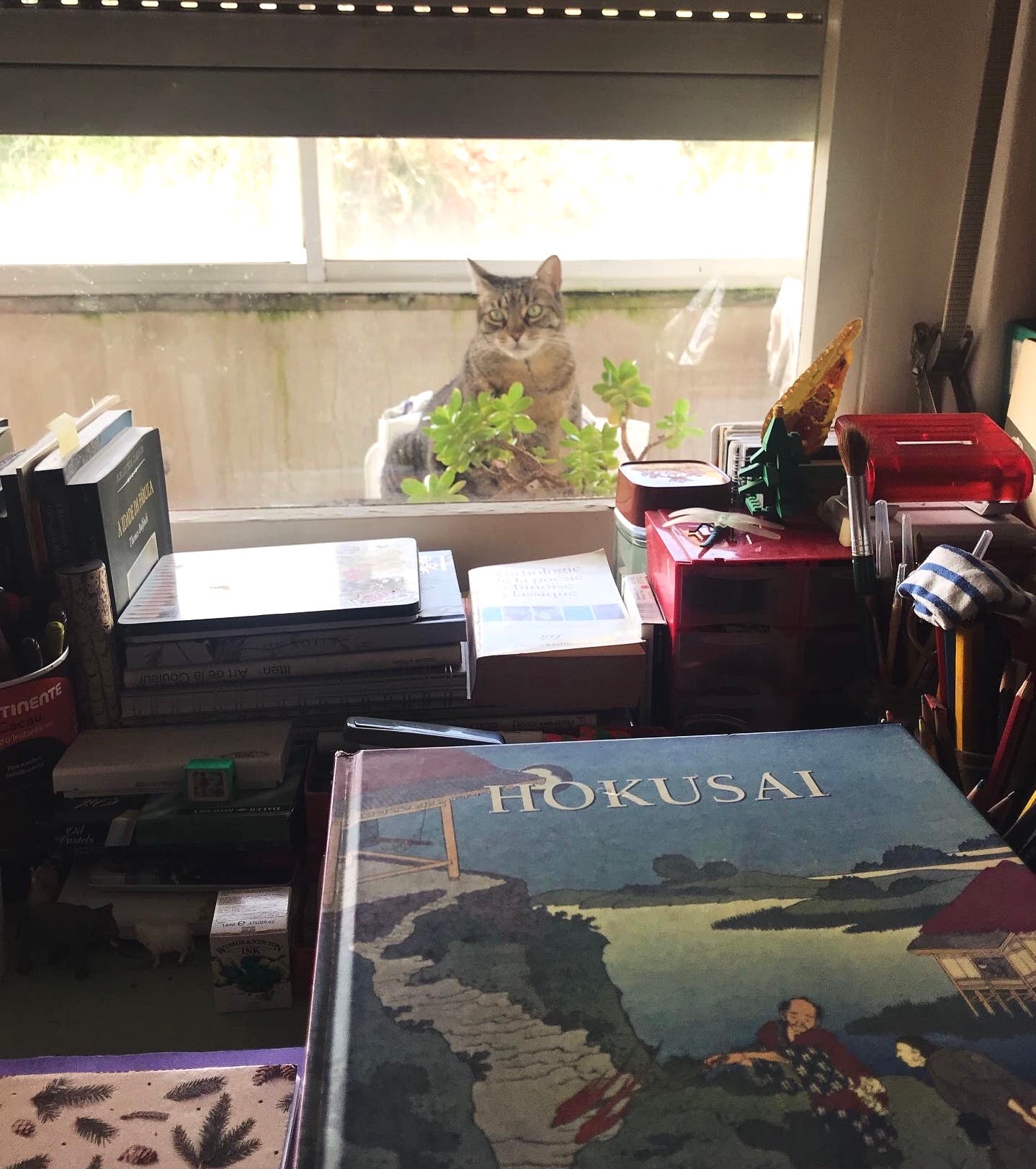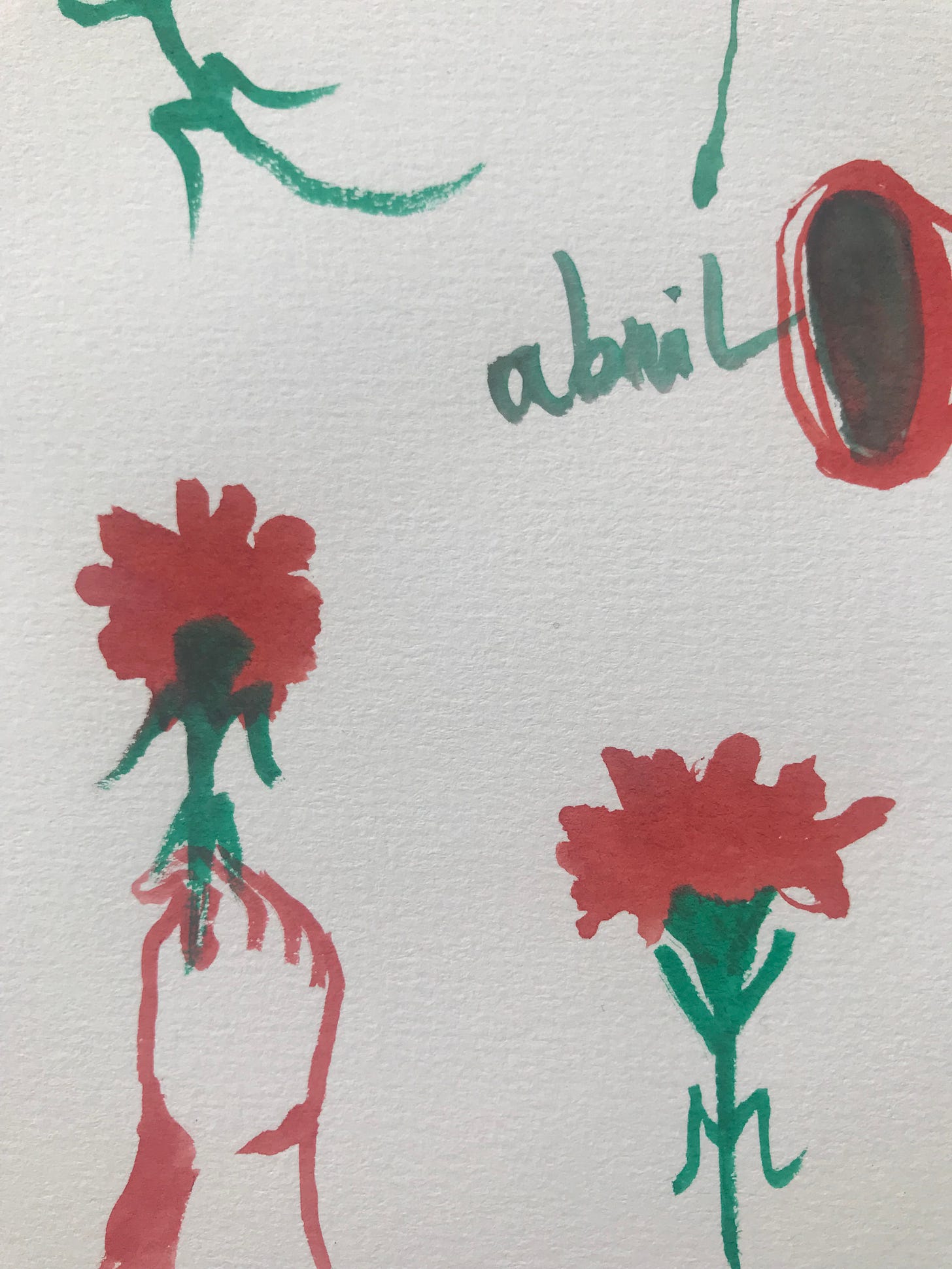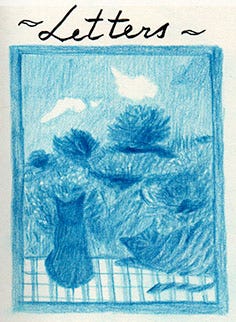21 de Março, 2024/March 21th, 2024
For English scroll down
“Les entrelacs sont un motif qui apparaît constamment dans l’art celtique, et surtout dans l’enluminure irlandaise. Ils symbolisent lá même notion que l’ouroboros: Le mouvement sans fin de l’évolution et de l’involution à travers l’enchevêtrement des faits cosmiques et humanos.”
Dictionnaire des Symboles”, Jean Chevalier e Alain Gheerbrant, Bouquins 1982
Acho que foi o movimento que primeiro me despertou a curiosidade- entrelaçar. Um movimento constante, uma forma evolutiva que cria um caminho enquanto se enlaça, uma ida e uma volta e que às vezes finda num pequeno labirinto sob o nosso olhar. Observo que se fizermos o caminho ao contrário, agora de dentro para fora, temos a possibilidade de sair. Um movimento infinito desenhado a verde pela planta.
Se nos movimentos cíclicos e sazonais vejo o vale mudar e voltar ao princípio, sempre igual e sempre diferente, no entrelaçar vejo mais de perto e mais devagar.
Atravesso a ponte de madeira sob a linha de água e à minha volta a Ipomoea indica, Boas-noites, entrelaça-se nos ramos e nas folhas dos choupos negros. Volta a volta ela faz o seu caminho e sobre a minha cabeça ela apoia-se num ramo mais longo e voa, corajosamente começa a formar um arco entrelaçada nas folhas mais próximas dos choupos do outro lado da ponte. No Verão os choupos são floridos pelas suas flores azul violeta.
Na comunidade herbácea são as canas do canavial que suportam o caminho ascendente das Corriola-das-sebes, Calystegia sepium. E mesmo em frente, do outro lado do caminho, uma Camomila-sem-cheiro dá a mão, devia escrever dá o caule, a uma bonita Corriola-campestre, Convolvulos arvenses. Lembro-me de ver a mesma trepadeira na comunidade que encontrei em volta do candeeiro eléctrico , com as suas flores delicadas que começam brancas e abrem num rosa muito claro.
E este movimento de entrelaçar que vou encontrando à minha volta fascina-me. Ver a planta, volta à volta, neste caminho que nos revela o seu saber - devagar dá uma volta, liga, recomeça, outra volta e liga. Princípio e fim, princípio.
“Há uma outra fonte, mais natural, numa camada mais profunda da alma, onde reencontramos já não o indivíduo, mas o próprio mundo. A espiral não é apenas um gesto humano primordial, mas, como movimento, um acontecimento primordial, no qual se toma parte.”
“Estudos do Labirinto” de Károly Kerényi, Assírio & Alvim 2008
No Verão passado encontrei um novo entrelaçar quando vi as bagas verdes da Tamus communis ( uva-de-cão ou baganha). Não conhecia esta planta trepadeira quando reparei que crescia em redor das oliveiras que ladeiam um dos caminhos da encosta direita do vale. As suas bagas maduras ficam vermelhas e nessa altura é ainda mais fácil dar por ela. Quando uma das oliveiras de maior dimensão estava cheia de novas ramagens, que pendiam por ainda serem muito finas, a Tamus communis olhou para cima e viu um convite para subir. O seu entrelaçar tomou uma nova direcção, a caminho do céu! Cá em baixo, com os pés no chão não me cansava de observar como estes dois seres se encontraram, o entrelaçar, as ligações, o laço forte que a trepadeira criou com a oliveira.
“Hashi significa “religar”. Sublinha as funções de ligação simultaneamente no tempo e no espaço, e dá às construções um particular significado, quase sagrado. Hashi significa também o espaço entre duas coisas, o tempo entre dois acontecimentos, e implica uma divisão do mundo. Hashi representa também as margens, os intervalos e o facto de ligar elementos. “
“A Dança da Vida - a outra dimensão do tempo” de Edward T. Hall, Relógio d’Água 1996
As trepadeiras caminham com graça e isso faz-me sorrir. Imagino o que pensam no momento em que acabam cada volta do seu entrelaçar, o que vêem quando criam uma nova ligação, quando se esticam, quando tentam alcançar, quando caminham mais devagar ou avançam velozes. Fico atenta a estes movimentos que acontecem no espaço e no tempo. Os intervalos, a respiração, o que vem a seguir. Paro para escutar. Sigo os seus caminhos, o seu caule verde e enquanto os meus olhos vêem, dentro de mim sigo também o meu caminho, espero que também com graça e alguns saltos de fé.
Cá dentro
Na cozinha fui surpreendida por um pequeno rebento verde que surgiu no meio de um resto de castanhas que tinha ficado esquecido numa taça. Esta casa vive mergulhada em humidade durante o Inverno e descobri que as partículas de água que pairavam no ar foram o suficiente para que da semente, a castanha, germinasse uma raiz que cresceu para baixo ( por isso não a vi) e que depois despontasse num rebento, para cima.
“Our understanding of how a plant knows up from down progressed remarkably over the course of the eighteenth and nineteenth centuries. First Duhamel revealed that seedlings reorient their growth so that roots grow down and shoots up, then Knight demonstrated that gravity was the reason for this “up-down growth”, and then the Darwins elucidated that the root tip contains the mechanism that senses the gravity. More than a century would pass before modern molecular genetic studies would confirm Darwin’s results, demonstrating that the cells in the extreme end of the root (in a region called the root cap) sense gravity and help a plant known where down is.”
“What a plant knows” de Daniel Chamovitz, Oneworld Publications 2012
Tenho desenhado em ponto pequeno para dois projectos. E comecei esta semana os esboços e a desenvolver as primeiras ideias para um projecto que me vai acompanhar até ao fim de Junho.
Comecei Abril em Março porque é urgente fazer!
“ This is precisely the time when artists go to work. There is no time for despair, no place for self-pity, no need for silence, no room for fear. We speak, we write, we do language. That is how civilization heal.”
Toni Morrison, The Nation 23 Março 2015
As Petit Collage estão disponíveis para venda, são uma primeira série das colagens que tenho vindo a fazer ultimamente. Já há algum tempo que não desenhava com papéis recortados e tenho gostado muito de regressar a esta prática!
Se gostarem de alguma podem adquiri-las na minha loja e se quiserem espreitar com mais tempo encontrarão por lá ainda alguns desenhos originais disponíveis para venda.
Com a loja finalmente a funcionar resolvi fazer algumas alterações por aqui: a partir de hoje todas as cartas/newsletters estarão sempre disponíveis gratuitamente, inclusivé a marginalia (mas sobre ela falarei com mais detalhe na próxima terça-feira). Na loja estarão disponíveis para venda os desenhos, colagens e fanzines que vou fazendo e podem também apoiar-me em Buy me a coffee.
Agradeço desde já o vosso apoio e companhia!
P.S.
Guardo o Post Scriptum para partilhar convosco o que gostei de ver, ouvir e ler.
Ainda inspirada pelo entrelaçar, os desenhos de Ruth Asawa .
Por causa das “petit collage” e do seu lado lúdico fiquei com vontade de rever o Circo de Alexander Calder.
Um livro que há muito queria ler e que descobri na semana passada.
E esta entrevista de Mary Oliver a que regresso quando às vezes em que me sinto um pouco sozinha no meu caminho.
Regresso na próxima semana com a Marginalia, fiquem bem!
Saudações do 5A com vista para o vale! Até para semana,
Débora Figueiredo
“Les entrelacs sont un motif qui apparaît constamment dans l’art celtique, et surtout dans l’enluminure irlandaise. Ils symbolisent lá même notion que l’ouroboros: Le mouvement sans fin de l’évolution et de l’involution à travers l’enchevêtrement des faits cosmiques et humanos.”
Dictionnaire des Symboles”, Jean Chevalier e Alain Gheerbrant, Bouquins 1982
I think it was the movement that first aroused my curiosity - intertwining. A constant movement, an evolutionary form that creates a path as it intertwines, a going and a returning, and sometimes ends in a small labyrinth under our gaze. I observe that if we make the path backwards, now from inside to outside, we have the possibility to exit. An infinite movement drawn in green by the plant.
In the cyclical and seasonal movements, I see the valley change and return to the beginning, always the same and always different, but in intertwining, I see closer and slower.
I cross the wooden bridge beneath the waterline, and around me, the Ipomoea indica, Goodnights, intertwines in the branches and leaves of the black poplars. Round and round, it makes its way, and above my head, it leans on a longer branch and flies, bravely beginning to form an arch entwined in the leaves closest to the poplars on the other side of the bridge. In summer, the poplars are adorned with their violet-blue flowers.
In the herbaceous community, it's the reeds of the cane field that support the upward path of the Hedge Bindweed, Calystegia sepium. And right in front, on the other side of the path, a Scentless Mayweed extends its stem to a beautiful Field Bindweed, Convolvulus arvensis. I remember seeing the same vine in the community I found around the street lamp, with its delicate flowers that start white and open into a very light pink.
And this intertwining movement that I keep encountering around me fascinates me. Seeing the plant, round and round, on this path that reveals its knowledge to us - slowly it takes a turn, connects, starts again, another turn and connects. Beginning and end, beginning.
"There is another source, more natural, in a deeper layer of the soul, where we rediscover not the individual, but the world itself. The spiral is not only a primordial human gesture, but as a movement, a primordial event in which one takes part."
“Labyrinth Studies” by Károly Kerényi
Last summer, I discovered a new intertwining when I saw the green berries of Tamus communis (black bryony or lady's-seal). I wasn't familiar with this climbing plant until I noticed it growing around the olive trees that flank one of the paths on the right slope of the valley. Its ripe berries turn red, making it even easier to spot. When one of the larger olive trees was filled with new branches, which drooped because they were still very thin, Tamus communis looked up and saw an invitation to climb. Its intertwining took a new direction, heading towards the sky! Down here, with my feet on the ground, I couldn't stop observing how these two beings met, the intertwining, the connections, the strong bond that the vine created with the olive tree.
"Hashi" means "to reconnect." It emphasizes the functions of connection simultaneously in time and space, giving constructions a particular, almost sacred meaning. "Hashi" also signifies the space between two things, the time between two events, and implies a division of the world. It also represents margins, intervals, and the act of connecting elements.
“The Dance of Life” by Edward T. Hall
The vines move gracefully, and that makes me smile. I imagine what they think as they finish each turn of their intertwining, what they see when they create a new connection, when they stretch, when they reach out, when they move slower or advance swiftly. I pay attention to these movements that occur in space and time. The pauses, the breath, what comes next. I stop to listen. I follow their paths, their green stems, and while my eyes see, inside me, I also follow my path, hoping to do so with grace and a few leaps of faith.
Inside
In the kitchen, I was surprised by a small green shoot that emerged from the midst of some leftover chestnuts that had been forgotten in a bowl. This house is immersed in moisture during the winter, and I discovered that the water particles suspended in the air were enough for a root to sprout from the seed, the chestnut, growing downward (which is why I didn't see it), and then shoot upward into a sprout.
“Our understanding of how a plant knows up from down progressed remarkably over the course of the eighteenth and nineteenth centuries. First Duhamel revealed that seedlings reorient their growth so that roots grow down and shoots up, then Knight demonstrated that gravity was the reason for this “up-down growth”, and then the Darwins elucidated that the root tip contains the mechanism that senses the gravity. More than a century would pass before modern molecular genetic studies would confirm Darwin’s results, demonstrating that the cells in the extreme end of the root (in a region called the root cap) sense gravity and help a plant known where down is.”
“What a plant knows” de Daniel Chamovitz, Oneworld Publications 2012
I've been sketching on a small scale for two projects. And this week, I began sketching and developing the initial ideas for a project that will accompany me until the end of June.
I started April in March because it's urgent to get things done!
“ This is precisely the time when artists go to work. There is no time for despair, no place for self-pity, no need for silence, no room for fear. We speak, we write, we do language. That is how civilization heal.”
Toni Morrison, The Nation, March 22nd, 2015
The Petit Collage pieces are available for sale, comprising the first series of collages I've been working on lately. It's been a while since I've drawn with cut papers, and I've really enjoyed returning to this practice!
If you like any of them, you can purchase them in my store. And if you want to take a closer look at your own pace, you'll find some original drawings available for sale there as well.
With the store finally up and running, I've decided to make some changes around here: starting today, all letters/newsletters will always be available for free, including the marginalia (but I'll talk about that in more detail next Tuesday). In the store, you'll find drawings, collages, and fanzines available for sale, and you can also support me on Buy Me a Coffee.
I appreciate your support and company!
P. S.
I'll save the Post Scriptum to share with you what I enjoyed seeing, hearing, and reading.
Still inspired by intertwining, I highly recommend checking out the drawings of Ruth Asawa.
Because of the "Petit Collage" and its playful side, I felt like revisiting Alexander Calder's Circus.
E esta entrevista de Mary Oliver a que regresso quando às vezes em que me sinto um pouco sozinha no meu caminho.
I'll be back next week with the Marginalia. Take care!
Greetings 5A with a view to the valley! See you next tuesday,
Débora Figueiredo

